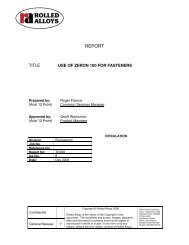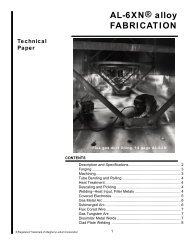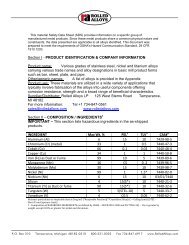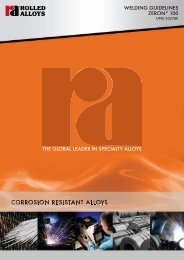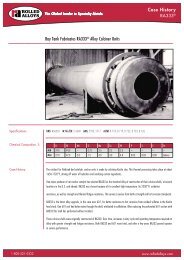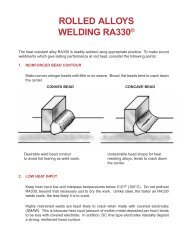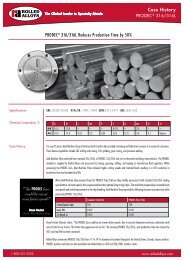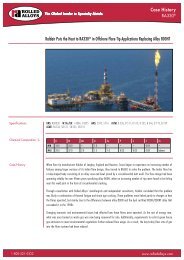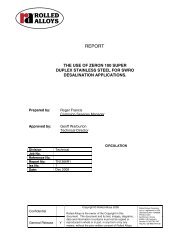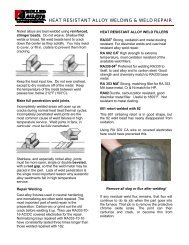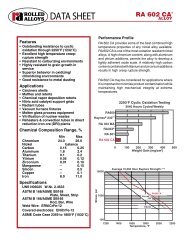ZERON 100 Chemical and Process Industries - Rolled Alloys
ZERON 100 Chemical and Process Industries - Rolled Alloys
ZERON 100 Chemical and Process Industries - Rolled Alloys
- No tags were found...
You also want an ePaper? Increase the reach of your titles
YUMPU automatically turns print PDFs into web optimized ePapers that Google loves.
REPORT<strong>ZERON</strong> <strong>100</strong> SUPERDUPLEX STAINLESSSTEEL IN THE CHEMICAL ANDPROCESS INDUSTRIESPrepared by:Roger FrancisCorrosion Services ManagerApproved by:Glenn ByrneManaging DirectorDivision EngineeringJob No.Reference No.Report No: TN1387Iss No. 3Date: Nov 2008CIRCULATIONConfidentialGeneral ReleaseYCopyright © <strong>Rolled</strong> <strong>Alloys</strong> 2008<strong>Rolled</strong> <strong>Alloys</strong> is the owner of the Copyright in thisdocument. The document <strong>and</strong> its text, images, diagrams,data <strong>and</strong> information it contains must not be copied orreproduced in whole or in part, in any form or by anymeans, without the prior written consent of <strong>Rolled</strong> <strong>Alloys</strong><strong>Rolled</strong> <strong>Alloys</strong> CompanyLtd co. registered in USA(Delaware)-#37-1540008,PO Box 1287,Northbrook, Illinois60065. UK CompanyNumber FC027795 VATReg No. GB 803 8704 36
<strong>ZERON</strong> <strong>100</strong> SUPERDUPLEX STAINLESS STEEL IN THE CHEMICALAND PROCESS INDUSTRIESSECTIONDESCRIPTIONSUMMARY1.02.03.03.13.23.33.43.53.64.05.0INTRODUCTIONALLOY PROPERTIESCORROSIONSeawater/BrinesStress Corrosion CrackingMineral AcidsOrganic AcidsCaustic SodaErosionSERVICE EXPERIENCECONCLUSIONSREFERENCESTable 1.Table 2.Table 3.Table 4.The composition of some stainless steels used by the chemical <strong>and</strong>process industries.Minimum mechanical properties of some stainless steels commonlyused by the chemical <strong>and</strong> process industries.Design stresses for some common stainless steels at roomtemperature.The results of corrosion tests in simulated TPA fluids.Figure 1. Threshold temperature for chloride SCC of some alloys in 3%sodium chloride.Figure 2.Iso-corrosion curves (0.1mm/y) for some stainless steels in aeratedsulphuric acid.Copyright © <strong>Rolled</strong> <strong>Alloys</strong> 2008Report No. TN1387Issue No. 3 Page 2 of 18
Figure 3.Figure 4.Figure 5.Figure 6.Iso-corrosion curves (0.1mm/y) in sulphuric acid plus 2,000mg/1chloride.Corrosion of some common stainless steels in boiling 50% aceticacid plus formic acid.Corrosion of some common stainless steels in 80 wt % acetic acidplus 1.5g/L bromide <strong>and</strong> 0.5g/L manganese at 90° C.Iso-corrosion curves (0.1mm/y) for some stainless steels in causticsoda.Figure 7. Weight loss in erosion test at 40m/sec (pH=3.5; temperature=55° C;chloride=25g/l).Figure 8.Figure 9.Figure 10.Zeron <strong>100</strong> vessel supplied to a UK pigments manufacturer.Condenser in Zeron <strong>100</strong> for a VCM plant.Centrifuge basket in Zeron <strong>100</strong> for an FGD plant.Copyright © <strong>Rolled</strong> <strong>Alloys</strong> 2008Report No. TN1387Issue No. 3 Page 3 of 18
SUMMARYThis report describes the physical <strong>and</strong> mechanical properties of Zeron <strong>100</strong>, as well as itscorrosion performance in a range of common fluids found in chemical plants. Some examplesare given to demonstrate the diversity of uses of Zeron <strong>100</strong> by the chemical <strong>and</strong> processindustries.Copyright © <strong>Rolled</strong> <strong>Alloys</strong> 2008Report No. TN1387Issue No. 3 Page 4 of 18
Code cases for Zeron <strong>100</strong> have been processed by the relevant authorities for PD5500<strong>and</strong> ASME VIII division 1 for vessels <strong>and</strong> ASME B31.3 for pipes. The approved designstresses at room temperature are shown in Table 3 <strong>and</strong> it can be seen that Zeron <strong>100</strong>offers the highest design stresses. With vessels, PD5500 is preferred for designbecause of the greater potential wall thickness savings. The largest vessel designed toPD5500 in Zeron <strong>100</strong> is 3.5m diameter, 4.5m tall <strong>and</strong> 20mm thick <strong>and</strong> it has been inservice with a UK pigments manufacturer since 1996 with no problems.Zeron <strong>100</strong> is readily welded by all the commonly used arc welding processes. It isusually welded with Zeron <strong>100</strong>X consumables, which contain 2 to 2.5% extra nickel toensure the correct phase balance of the weld metal in the as-welded condition. Like allhigh alloy stainless steels, Zeron <strong>100</strong> requires welders experienced in stainless steelfabrication working to approved <strong>and</strong> qualified procedures.Supply is not a problem because Zeron <strong>100</strong> is readily available in all the common productforms, including castings, pipes, fittings, flanges, plates, bar, billet, fasteners etc. A largestock is currently held in RA ® Materials, Manchester warehouse in all these productforms.3. CORROSION3.1 Seawater/BrinesZeron <strong>100</strong> was invented initially as a seawater grade alloy for pumps, valves <strong>and</strong> piping.It has been in service as castings since 1986 <strong>and</strong> as a wrought alloy since 1990.Seawater applications cover Europe, the Middle East <strong>and</strong> the Far East. Becauseseawater is a common coolant in many chemical <strong>and</strong> process plants, Zeron <strong>100</strong> is anattractive alloy for heat exchangers cooling aggressive chemicals.Zeron <strong>100</strong> also resists localised corrosion in neutral chloride solutions over a wide rangeof concentrations <strong>and</strong> temperatures. The alloy has found uses in brine discharge lines indesalination plants as well as in crystallisers <strong>and</strong> evaporators.3.2 Stress Corrosion CrackingIn hot fluids containing chlorides, stress corrosion cracking (SCC) can cause failures ofsome stainless steels. Figure 1 shows the threshold temperature for chloride SCC ofsome common alloys in 3% sodium chloride. The results show that Zeron <strong>100</strong> hassuperior resistance to chloride SCC compared with both 316L <strong>and</strong> 22% Cr duplex <strong>and</strong>similar to that of alloy C-276. Although 6%Mo austenitic can be used to highertemperatures than 22%Cr duplex, it is not as resistant to chloride SCC as Zeron <strong>100</strong>.The safe operating temperature increases as the chloride content decreases. However,the safe temperature decreases if more aggressive cations are present, such asmagnesium.3.3 Mineral AcidsZeron <strong>100</strong> has excellent resistance to mineral acids. Figure 2 shows the 0.1mm/y isocorrosioncurve for Zeron <strong>100</strong> compared with some other alloys in sulphuric acid. It isclear that Zeron <strong>100</strong> has superior resistance to sulphuric acid compared with many otherCopyright © <strong>Rolled</strong> <strong>Alloys</strong> 2008Report No. TN1387Issue No. 3 Page 6 of 18
common grades of stainless steel. Its resistance is similar to that of alloy C-276 overmost of the concentration range, except from 50% to 90wt% acid. At acid contentrations>90 wt% Zeron <strong>100</strong> has excellent resistance to corrosion <strong>and</strong> the alloy finds uses in theheat recovery sections of sulphuric acid plants where the 98% acid is around 200° C (2).In the presence of oxidisers, such as ferric ions, cupric ions, nitric acid etc. theperformance of Zeron <strong>100</strong> increases substantially. A good example of this is thereconcentration of sulphuric acid containing 0.15% nitric acid, used in the manufacture ofexplosives. Acid at 70wt% concentration is heated at 125° C as part of the concentrationprocess. The corrosion rates with <strong>and</strong> without nitric acid are shown below.70% acid (no nitric); corr. rate >> 1mm/y70% acid (+ 0.15% HNO 3 ); corr. rate = 0.029mm/yThe performance of Zeron <strong>100</strong> in sulphuric acid is discussed at length in anotherpublication (2).In some processes the sulphuric acid contains chlorides. Figure 3 shows the isocorrosioncurves in sulphuric acid containing 2,000mg/l chloride. The data shows theexcellent performance of Zeron <strong>100</strong> compared with some other stainless steels. In thepresence of oxidisers (e.g. Fe 3+ ) the performance can improve, but if the concentration ofoxidiser is too high the potential can exceed the pitting potential <strong>and</strong> localised attack willoccur. No data was available for alloy C-276 in this environment.In hydrochloric acid Zeron <strong>100</strong> also shows good resistance, better than most stainlesssteels <strong>and</strong> similar to data for alloy C-276 up to ~7wt % acid (Figure 4). This has led tosome applications, as described in section 4.Zeron <strong>100</strong> has good resistance to phosphoric acid, particularly in the presence of halides,as occurs in the production of fertilisers. This is described in detail elsewhere (3).3.4 Organic AcidsMost pure organic acids are not very corrosive <strong>and</strong> can be h<strong>and</strong>led by alloys such as316L up to quite high concentrations <strong>and</strong> temperatures. The exception is formic acid,which is quite aggressive. Formic acid is produced during the manufacture of acetic acid<strong>and</strong> the mixture can be very aggressive. Superduplex stainless steel has very goodresistance to such mixtures (4), as shown in Figure 5. The results show that superduplexperforms better than many common stainless steels <strong>and</strong> was equivalent to alloy C-276.Zeron <strong>100</strong> was exposed in a commercial acetic acid plant under oxidising conditions fortwo years, with the following results:Acetone 2% Water 19%Formic Acid 10% Acetic Acid 42%Propionic Acid 8%Temperature - 188°CPressure - 680 psiAlloy C-276 - 0.<strong>100</strong>mm/yAlloy 20 - 0.075mm/yZeron <strong>100</strong> - 0.045mm/yCopyright © <strong>Rolled</strong> <strong>Alloys</strong> 2008Report No. TN1387Issue No. 3 Page 7 of 18
Zeron <strong>100</strong> outperformed the then currently used nickel alloys.In some processes halides, such as chlorides or bromides, are present <strong>and</strong> these makethe process more corrosive. Laboratory tests in 80wt% acetic acid with 1.5g/l bromideion <strong>and</strong> 0.5g/l manganese ion at 90°C, showed the ex cellent corrosion resistance ofZeron <strong>100</strong> compared with other stainless alloys (Figure 6).Test were conducted at high temperature to simulate conditions found in the productionof terephthalic acid <strong>and</strong> dimethyl terephthalate. The results, in Table 4, show thesignificantly lower corrosion rate of Zeron <strong>100</strong> compared with alloy 317L.3.5 Caustic SodaFigure 7 shows the iso-corrosion curves (0.1mm/y) for Zeron <strong>100</strong> in caustic sodacompared with 316L. The results show the superior corrosion resistance of Zeron <strong>100</strong>,particularly at dilute concentrations (0-30wt%). The presence of chloride up to severalwt% has no effect on the corrosion of Zeron <strong>100</strong> in caustic soda (5). Under highlyoxidising conditions, Zeron <strong>100</strong>, like many other stainless steels, can suffer causticcracking. However, the threshold conditions for caustic SCC are over a narrowconcentration range <strong>and</strong> at much higher temperatures than are required to causecracking of 316L. Zeron <strong>100</strong> also offers a more cost effective option compared withnickel alloys over a wide range of temperatures <strong>and</strong> concentrations.3.6 ErosionIn addition to its excellent corrosion resistance, Zeron <strong>100</strong> also has good resistance toerosion <strong>and</strong> corrosion in abrasive slurries, <strong>and</strong> this is discussed in detail elsewhere (6).Figure 8 shows the relative performance of a number of stainless steels tested at40m/sec in a brine containing 25g/l chloride <strong>and</strong> 640mg/l sharp s<strong>and</strong> at 55° C <strong>and</strong> a pH of3.5. These results show the high resistance of Zeron <strong>100</strong> to erosion in this environment.4. SERVICE EXPERIENCEBelow are some examples of the use of Zeron <strong>100</strong>, showing the diverse range ofapplications in the chemical <strong>and</strong> process industries.Zeron <strong>100</strong> has been used in synthetic rubber production. Winnik el al (7) described theuse of Zeron <strong>100</strong> for the pump <strong>and</strong> pipework in a polymerisation reactor cycle (Methylchloride plus AlCl 3 catalyst). This application involves cycling between – 120°C <strong>and</strong> +82°C. Hence the superduplex has to have proven fra cture toughness at the lowestoperation temperature. The material consistently passed the charpy test specification of40J minimum <strong>and</strong> 0.38mm lateral expansion at –120° C. The successful use of Zeron<strong>100</strong> for this application has led to several repeat orders. Zeron <strong>100</strong> was chosen becauseof its combination of high strength <strong>and</strong> corrosion resistance. The alternative was a nickelalloy, which would have been much more expensive. All of the reactors in the USA <strong>and</strong>UK have now had Zeron <strong>100</strong> pumps fitted.The resistance of Zeron <strong>100</strong> to corrosion in strong brines <strong>and</strong> other concentratedsolutions was described above. Zeron <strong>100</strong> was used for the pump discharge piping in asodium sulphate crystallizer installed in South Africa. The unit operates at 105° C with a30 wt% solution of sodium sulphate plus solids. The concern in the discharge pipeworkCopyright © <strong>Rolled</strong> <strong>Alloys</strong> 2008Report No. TN1387Issue No. 3 Page 8 of 18
was both corrosion <strong>and</strong> erosion. The 1200mm diameter ducting was fabricated fromZeron <strong>100</strong> plate <strong>and</strong> it has been in successful service since 2001.Weir Materials delivered in 1995 the largest super duplex vessel at that time(approximately 3.5m diameter <strong>and</strong> 5.6m long) (Figure 9). The vessel operates at 135° C<strong>and</strong> is used for solvent recovery by a major pigment producer. The environment variesfrom acid to alkaline <strong>and</strong> contains chlorides. A previous vessel had been cast-iron, butwith the upgrading of the process <strong>and</strong> the increase in the temperature, the corrosionallowance would have resulted in excessively thick castings. Zeron <strong>100</strong> proved to be acost effective alternative with proven resistance to both corrosion <strong>and</strong> stress corrosioncracking in the working fluid.The Zeron <strong>100</strong> vessel was fabricated from 20mm plate whereas the cast iron would havebeen 150mm thick. The weight of the Zeron <strong>100</strong> vessel was 20 tonnes, whereas a castironvessel would have exceeded <strong>100</strong> tonnes. This is an example of vessel design usingPD5500 to take maximum advantage of the mechanical properties of Zeron <strong>100</strong>. Thevessel was inspected after 2 years in service <strong>and</strong> was found to be in excellent condition.Following this a 316L vessel suffering chloride SCC has been replaced with Zeron <strong>100</strong> atthe same plant.The successful trials of Zeron <strong>100</strong> at a UK acetic acid plant described in a previoussection, have led to the installation of a Zeron <strong>100</strong> valve <strong>and</strong> piping, replacing shorterlived nickel alloy components. Zeron <strong>100</strong> pipes, fittings <strong>and</strong> flanges have also been usedin parts of the acetic acid plant in the Jubail Acetyl Complex, Saudi Arabia, due to comeon line in 2009.In vinyl chloride monomer production, part of the process involves the cooling of gaseousproducts. Under certain conditions this results in hydrochloric acid condensing on theheat exchanger tubes. Zeron<strong>100</strong> was selected for the heat exchanger tubes because ofits excellent resistance to both the brackish water cooling medium <strong>and</strong> hydrochloric acidon the process side (8). Figure 10 shows the unit during construction. Zeron <strong>100</strong> hasbeen selected for the heat exchanger tubes in two subsequent plant expansions.Another hydrochloric acid application involved the production of rutile by the hydrochloricacid route at a plant in the Middle East. The resistance of Zeron <strong>100</strong> to hydrochloric acidled to its selection for the spent acid lines.Zeron <strong>100</strong> is also widely used by original equipment manufacturers because of its readyavailability. Components such as agitators, filters, mixers etc. are routinely produced.Figure 11 shows the basket from a centrifuge at an FGD plant where gypsum isseparated from a corrosive limestone slurry. Similar baskets have been used in the UK ina plant producing rutile by the sulphuric acid route, to separate ferrous sulphate crystalsfrom spent acid. This has resulted in large annual savings in maintenance compared withthe previous 316L baskets, which corroded rapidly.Some other applications include a citric acid plant in Norway, paper machines inAustralia, a TPA plant in the USA <strong>and</strong> a fertiliser plant in Norway.Copyright © <strong>Rolled</strong> <strong>Alloys</strong> 2008Report No. TN1387Issue No. 3 Page 9 of 18
5. CONCLUSIONS1. Zeron <strong>100</strong> has excellent resistance to general corrosion, pitting <strong>and</strong> stress corrosioncracking in a wide range of fluids.2. The high strength of Zeron <strong>100</strong> offers potential cost savings over austenitic alloys,particularly at higher temperatures <strong>and</strong> pressures.3. Zeron <strong>100</strong> can offer benefits not only over lower alloyed stainless steels, but also overnickel-base alloys for some applications.REFERENCES1. C W Kovach <strong>and</strong> J D Redmond, Paper 267, Corrosion ’93. New Orleans, LA, USA.March 1993. NACE.2. WM&F Technical Report TN1290R4, Dec 2006.3. WM&F Technical Report TN1105R2, March 2002.4. P Kangas, B Walden <strong>and</strong> M Nicholls, Paper 86.Duplex Stainless Steels ’94. Glasgow, UK. Oct 1994. Publ d by TWI.5. A Turnbull, A Griffiths <strong>and</strong> T Reid.Stainless Steel World, Dec 1999, page 63.6. WM&F Technical Report TN781R3, June 2005.7. S Winnik & B J Fitzgerald, Paper No. 390, Corrosion ’94, Baltimore USA.March 1994, NACE.8. M Zaher, Stainless Steel World Conference 2003, Maastricht, Holl<strong>and</strong>, Nov 2003. KCI,page 122,Copyright © <strong>Rolled</strong> <strong>Alloys</strong> 2008Report No. TN1387Issue No. 3 Page 10 of 18
TABLE 1.The composition of some stainless steels commonly used by the chemical <strong>and</strong>process industries.ALLOYNominal Composition (wt%)Fe Cr Ni Mo N Cu WPREN*<strong>ZERON</strong> <strong>100</strong> (Wrought) bal 25 7 3.5 0.25 0.7 0.7 > 40<strong>ZERON</strong> <strong>100</strong> (Cast) bal 25 8 3.5 0.25 0.7 0.7 > 40316L bal 17 10 2 - - - 2422% Cr Duplex bal 22 5 3 0.16 - - 35904L bal 20 25 4.5 - 1.5 - 356%Mo Aust. bal 20 18 6 0.2 0.7 - 43C - 276 5 15 bal 16 - - 3.5 68bal = balancePREN = %Cr + 3.3%Mo + 16%NCopyright © <strong>Rolled</strong> <strong>Alloys</strong> 2008Report No. TN1387Issue No. 3 Page 11 of 18
TABLE 2.Minimum mechanical properties of some stainless steels commonly used by thechemical <strong>and</strong> process industries.ALLOY0.2% PROOFSTRESS(MPa)UTS(MPa)ELONG n(%) HARDNESS*(HRC)<strong>ZERON</strong> <strong>100</strong> (Wrought) 550 750 25 28<strong>ZERON</strong> <strong>100</strong> (Cast) 450 700 25 24316L 213 500 45 2222%Cr Duplex 450 650 25 28904L 230 530 40 226%Mo Aust. 300 650 35 22C – 276 283 690 40 <strong>100</strong>+* - maximum+ - HRBTABLE 3.Design stresses for some common stainless steels at room temperature.ALLOYPD 5500(Vessels)DESIGN STRESS (MPa)ASME VIII Div. 1(Vessels)ASME B31.3(Pipes)<strong>ZERON</strong> <strong>100</strong> (Wrought) 319 214 250316L 150 115 11522%Cr Duplex 289 177 2076%Mo Aust. NL 185 207C-276 NL 188 188NL – not listedCopyright © <strong>Rolled</strong> <strong>Alloys</strong> 2008Report No. TN1387Issue No. 3 Page 12 of 18
TABLE 4.The results of corrosion tests in simulated TPA fluids.ALLOYCORROSION RATE (mm/y)FLUID 1* FLUID 2 +317LWelded 317L0.440.470.670.68Zeron <strong>100</strong>Welded Zeron <strong>100</strong>0.0040.0060.0110.016* - Fluid 1: 75% Acetic Acid with traces of Br, Cu <strong>and</strong> Mn @ 175° C.+ - Fluid 2: 96% Acetic Acid with traces of Br, Cu <strong>and</strong> Mn @150° C.FIGURE 1 Threshold temperature for chloride SCC ofsome alloys in 3% sodium chloride250200Temperature (° C)150<strong>100</strong>500316L 22Cr Duplex 904L 6Mo Aust. <strong>ZERON</strong> <strong>100</strong> C-276AlloyCopyright © <strong>Rolled</strong> <strong>Alloys</strong> 2008Report No. TN1387Issue No. 3 Page 13 of 18
FIGURE 2 Iso-corrosion curves (0.1mm/y)for some stainless steels in aeratedsulphuric acid130120110Boiling PointCurve<strong>100</strong>Temperature (° C)90807060904L<strong>ZERON</strong> <strong>100</strong>Alloy C-27650316S32750406%Mo300 10 20 30 40 50 60 70 80 90 <strong>100</strong>Acid Concentration (wt%)FIGURE 3 Iso-corrosion curves (0.1mm/y) insulphuric acid plus 2,000mg/l chloride120110Boiling PointCurve<strong>100</strong>90Temperature (° C)807060506% MoAust904LS32750<strong>ZERON</strong> <strong>100</strong>40316L30200 10 20 30 40 50Acid Concentration (wt%)Copyright © <strong>Rolled</strong> <strong>Alloys</strong> 2008Report No. TN1387Issue No. 3 Page 14 of 18
Figure 4 Iso-corrosion curves (0.1mm/y) ofsome stainless steels in hydrochloric acid120110<strong>100</strong>Boiling Point Curve90Temperature (° C)807060506MoAust316LS32750<strong>ZERON</strong> <strong>100</strong>C-2764030200 1 2 3 4 5 6 7 8Acid Concentration (wt%)FIGURE 5 Corrosion of some commonstainless steels in boiling 50% acetic acidplus formic acid0.30.25316LCorrosion Rate (mm/y)0.20.150.1317L22CrDuplex0.056%Mo Aust. SuperduplexNo attack00 5 10 15 20 25 30Formic Acid (wt%)Copyright © <strong>Rolled</strong> <strong>Alloys</strong> 2008Report No. TN1387Issue No. 3 Page 15 of 18
FIGURE 6 Corrosion of some commonstainless steels in 80wt % acetic acid plus1.5g/L bromide <strong>and</strong> 0.5g/L manganese at90° C<strong>100</strong>Weight Loss (mg)1010.1316L 22Cr Duplex 6Mo Aust. Zeron <strong>100</strong>AlloyFIGURE 7 Iso-corrosion curves (0.1mm/y)for some stainless steels in caustic soda250230210190<strong>ZERON</strong> <strong>100</strong>Temperature (° C)170150130Boiling PointCurve1109070316L500 10 20 30 40 50 60 70Caustic Concentration (wt%)Copyright © <strong>Rolled</strong> <strong>Alloys</strong> 2008Report No. TN1387Issue No. 3 Page 16 of 18
FIGURE 8 Weight loss in erosion test at40m/sec (pH=3.5; temperature=55° C;chloride=25g/l)20191817Weight Loss (mg)16151413121110316L 22Cr Dup Alloy 825 Z<strong>100</strong>AlloyFIGURE 9. Zeron <strong>100</strong> vessel supplied to a UK pigments manufacturerCopyright © <strong>Rolled</strong> <strong>Alloys</strong> 2008Report No. TN1387Issue No. 3 Page 17 of 18
FIGURE 10. Condenser in Zeron <strong>100</strong> for a VCM plantFIGURE 11. Centrifuge basket in Zeron <strong>100</strong> for an FGD plantCopyright © <strong>Rolled</strong> <strong>Alloys</strong> 2008Report No. TN1387Issue No. 3 Page 18 of 18




